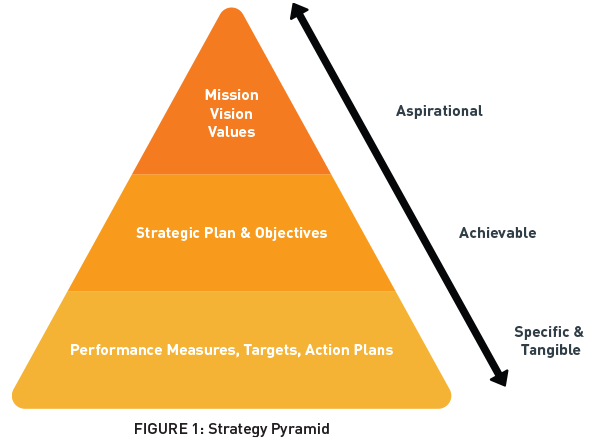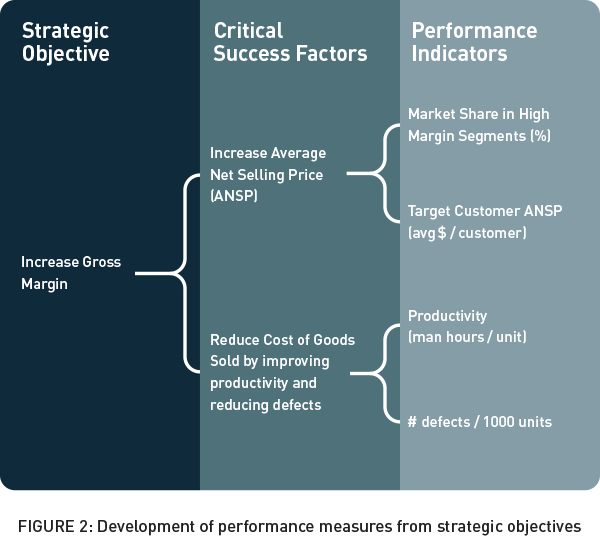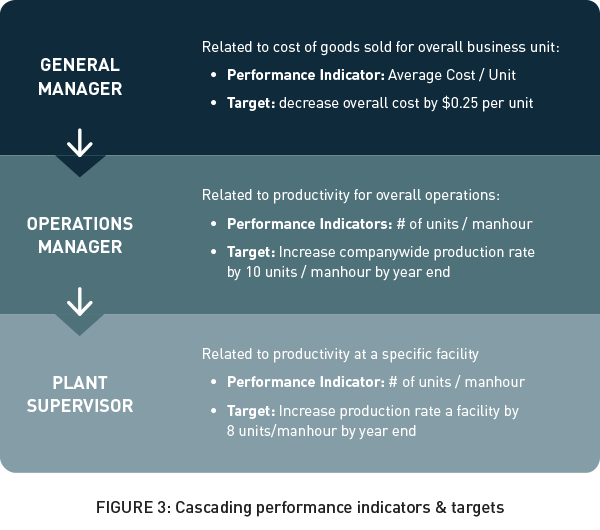White Paper
Using Performance Indicators to Drive Your Business Strategy
We’ve all heard the old management adage “you can’t manage what you don’t measure”, but in the world of big data where managers have countless reports and data at their fingertips, the key challenge for companies is to identify what they need to measure and to ensure they are measuring it properly. In many companies, existing reporting doesn’t provide the key data that employees need to identify performance issues and take action. Many organizations have a lot of financial accounting data but only a few measures that relate to strategic and non-financial performance. In many cases there is too much data, but too little information, with no linkage to the strategy of the business. How do you go about fixing this problem?
This article describes an approach to developing and aligning performance indicators with strategic objectives. Other processes, such as developing objectives and measures through a formal continuous improvement or ISO program can also be used. There is no single “right” way to decide on the best approach for your business; you need to consider what fits both within your business culture as well as the other systems you have in place.

A Balanced Approach To Identifying Strategic Objectives
It all starts with a strategy that flows from the company’s mission, vision and values (see Figure 1). If you do not have a strategic plan for your business, you need to start by developing a plan along with specific measurable objectives. These objectives could cover a broad range of perspectives, including these areas:
- Internal Processes - streamlining key processes, applying new technology to improve efficiency
- Environment and Community - support local businesses, community leadership and connecting with future employees
- Learning and Growth - increase expertise and skills through training or mentoring
- Financial - revenue growth, asset utilization, cash flow
- Customer Focus - customer satisfaction, identifying and targeting the most profitable customers
- Employee Satisfaction - staff retention and positive company culture
Identifying the Right Performance Indicators
Once strategic objectives are in place, you need to ask: what are the critical success factors required to drive each objective? For those success factors, develop a list of potential measures we call “indicators”, which will allow you to track performance. From this list of indicators, prioritize the ones that will have the biggest impact on achieving the strategic objectives. A simple example of how a strategic objective is converted to performance indicators is shown in Figure 2.
In order to measure performance, you must be able to readily obtain the data needed. Therefore, it is important to consider the availability of data, the effort required to obtain it, and any changes to systems or processes needed when selecting your performance indicators. If you are implementing performance indicators for the first time, keep it simple. Use data that is readily available in the organization; if you need to collect new data, ensure the benefit outweighs the cost and effort of obtaining it.
Cascading Objectives AND Performance Indicators to Align the Organization
Cascading your strategic objectives and indicators to all levels of the organization is a powerful way to align behaviour across your organization and improve performance. In order to do this successfully, you must develop indicators appropriate for the level of the organization at which they will be used. The manager or team using the indicator must be able to influence the results within their scope of responsibility. It is not necessary to have indicators related to each strategic objective; only the ones that are relevant to the manager or team. The best way to develop these indicators is to directly involve the people who are responsible for achieving results or have an influence on the outcome.

Setting Targets
Establishing targets enables you to check if you are on track in reaching your objectives. There are a number of ways to set targets, but the main point to keep in mind is that you want your teams to be motivated to achieve the results.
A target can be set using an external or internal benchmark. External bench- marks are applicable in cases where you have access to published data on industry best practices. Frequently they are most applicable in areas such as cost, quality, production cycle time, sales and marketing. Internal benchmarking involves analyzing internal data to understand where the company performance currently stands in order to set improvement targets. If you do not have the data, it may be necessary to collect it for a period of time (e.g. 3 months to 1 year depending on the measure) so as to establish a baseline.
Stretch targets are a great way to challenge and motivate staff to achieve great results. When setting stretch targets, be sure to break them down into more achievable targets or sub targets and quantify them in a shorter time frame. This will reduce the anxiety amongst staff and help them see what actions are needed to achieve results.
An example of how an objective can be cascaded through the organization, with targets set that are specific to the position in the company is shown in Figure 3.
Developing Reports and Dashboards
Once you’ve identified your performance indicators and set targets, the next step is to establish an approach to ongoing monitoring and reporting that can be used by managers and teams to track progress. The reporting framework must consider requirements of different levels of the organization and the reporting frequency that is required to support effective decision making.
A simple dashboard, which is a one-page tool displaying the performance indicators, targets, and historical data in a graphical form, can be an effective tool for reporting. The purpose of a dashboard is to provide a big picture view, focusing on the key performance indicators, and draw attention to areas of concern so that mangers can drill down into additional information that is needed to take action. There are a wide variety of software tools available for dashboard reporting; however, existing reporting systems can easily be used to create simple custom dashboards. In designing reports or dashboards, here are few things to keep in mind:
- Keep the data for each area of the business limited to a single, easy-to-read page
- Provide context to the data, historical trends and targets help the user to see if they are on track
- Use graphs or tables that clearly communicate the data
- Don’t change your reports too frequently, people need time to get used to them

Implementation
If performance indicators are new to your organization, you need to approach the design and implementation process as a change initiative. You should consider building these steps into your process:
1. Make it a priority – The President / CEO and senior management must support this initiative and ensure there is a sense of urgency within the organization to follow through with this project.
2. Develop a team – This group should have enough authority within the organization to lead the change and include people from various functions. This team needs to be given the time and resources to develop and implement the program. You may want to include an external consultant or advisor who can facilitate and guide the process.
3. Communicate – A clear and consis- tent message needs to be delivered to the business on the strategic objectives and changes that are being implemented to introduce performance indicators. This is not a one-time thing; use as many vehicles as possible to communicate the message (e.g. newsletters, staff meetings, workshops and one-on-one discussions with staff).
4. Empower employees – Involve a broad group of people in the process in order to gain their support and input in developing the performance measures through workshops, facili- tated meetings, or surveys tools.
5. Plan for and celebrate success – Set targets that are achievable so that people can see visible results from their efforts. Acknowledge and celebrate success, reward people who have been fundametal to achieving the results. Be sure to start this early enough in the implementation process to motivate staff and build momentum.
6. Keep the ball rolling – Establish an annual process to review and update your performance indicators to align with changes in strategy and set new targets. Continuously improve your approach by introducing per- formance measures to other levels of your businesses, or link it to your performance management system — any time you do this, remember to start at step one in this process.
Annual Review And Continuous Improvement
Once you’ve established a performance indicator system, you need to revisit and refine it to ensure relevance to the business. This should be linked to an annual strategic plan review and budget setting process. You should review which measures have worked well and which have not; it is especially important to look at which measures need to be changed based on adjustments to your strategic objectives. If you need to develop new measures, brainstorm on the success factors and identify new measures for each level within the organization. Regardless of whether the measures are new or not, you should be reviewing your annual performance and setting new targets for the upcoming year. Once these are established, they need to be communicated to the appropriate level of the company.
Identifying and linking performance indicators to the organization’s strategic objectives provides a foundation for aligning activities across the business. Developing simple reporting tools or dashboards will improve communication, decision making and performance monitoring. Overall, this process will help you to continuously improve your business and adjust your strategy as needed.
Further Reading:
Kaplan, R., and Norton, D., “Using the Balanced Scorecard as a Strategic Management System”, Harvard Business Review, July-August 2007
Marr, B., “How to Design Key Performance Indicators” Advanced Performance Institute, (www.ap-institute.com), 2010
Pateman, A., “5 East Steps for Developing Your BSC Measures”, Harvard Business Publishing, March – April 2004
Tips for Development Performance Indicators
- Link indictors to your strategic objectives and align them across your organization for maximum performance improvement
- Develop indicators that are measurable, simple and easy to understand for those responsible for the performance
- Indicators must provide meaningful information on progress relative to the objectives
- Ensure there is a clear definition and precise methodology for calculation
- Have clearly defined targets that are challenging and motivating, but obtainable with a reasonable amount of effort
- Review objectives, performance indicators and targets on an annual basis to ensure alignment with the business strategy
- Stay focused, limit number for each level or area of the business to 10 measures maximum
About Us
McNally Brown Group is a boutique management consulting and business advisory firm that works with companies to improve business performance. We work collaboratively with clients to conduct assessments, develop tools, and facilitate implementation of strategic initiatives in a broad range of areas including strategic planning and implementation of key performance indicators and dashboards.
Further Reading

Unlocking Growth: Digital Transformation for Small and Mid-Sized Businesses
Digital transformation is critical for small and mid-sized businesses (SMBs) to stay competitive and improve business performance. Adopting technology to better serve customers, improve processes and enhance efficiency can be a real competitive advantage. Here’s how SMBs can develop and execute a strategy for successful transformation.

The Power of a Clear Strategy: Unlocking Success for Your Business
Does your business have a clear strategy? And if you were to ask your leaders what that strategy is, would you hear consistent answers? If the answer is “no,” your business might be missing a critical piece of the puzzle when it comes to sustained success.



